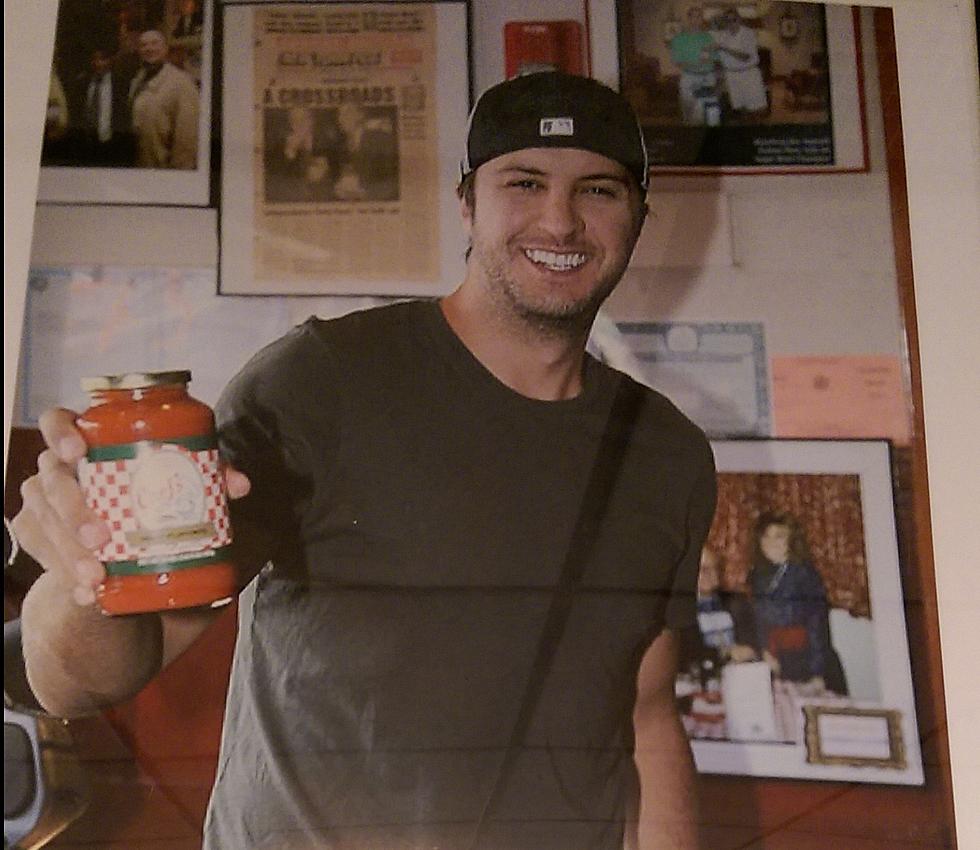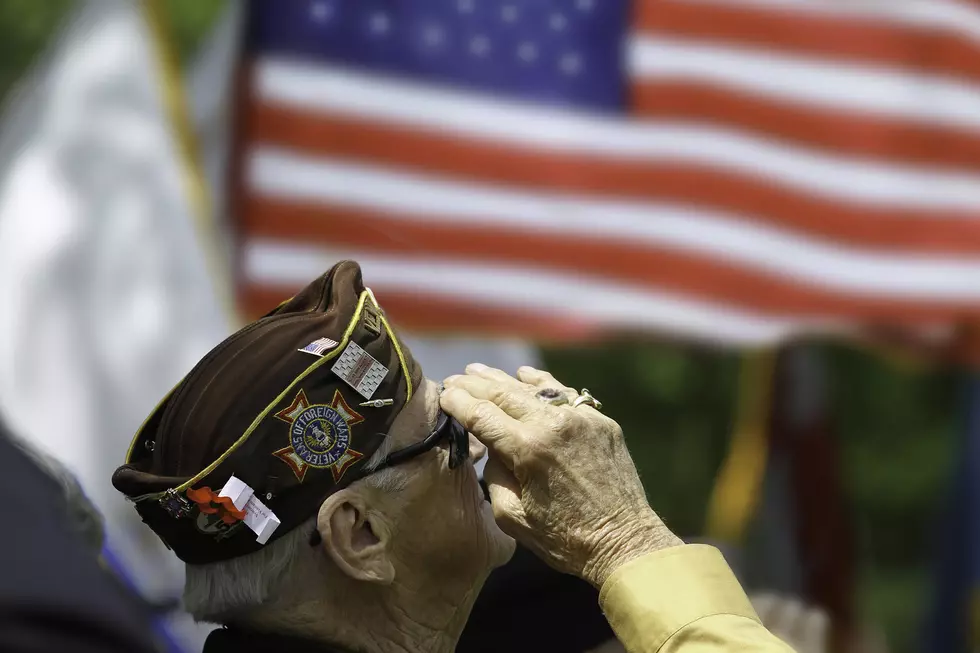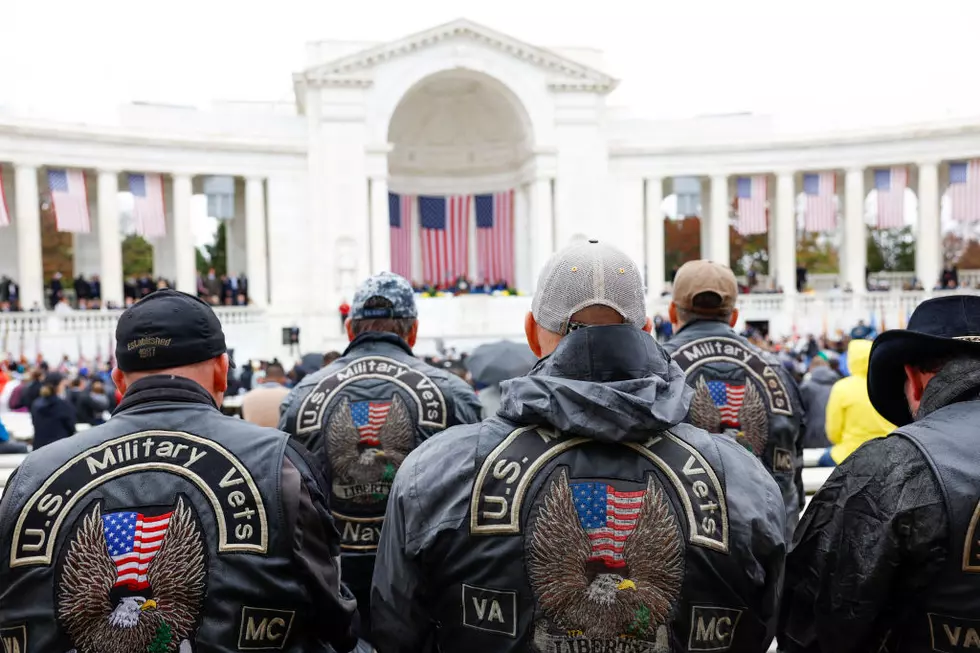![WYRK Honors Local Veterans — Read Their Stories [PICTURES]](http://townsquare.media/site/10/files/2011/08/soldier-return1.jpg?w=980&q=75)
WYRK Honors Local Veterans — Read Their Stories [PICTURES]
Happy Veterans Day! Today is a day set aside to honor our servicemen and -women -- and there's no better way to do that than to hear their stories.
Mary Baty from Montgomery Park Gracious Retirement Community compiled the memories of many vets living at the facility, and we wanted to share them with you.
"While I have learned a great deal about world history, I have learned far more about strength, tenacity, and courage," Mary wrote to help introduce the stories. "The greatest lesson being that everyone has a story unique to themselves. To judge someone at face value is to rob ourselves of real connection....Opening our minds and hearts to others allows us to learn, feel and grow."
Read on below to learn more about these brave men and women. And to all military members, current and past, thank you for your service.
Ben Hirsh, United States Marine Corp.
Ben enlisted in the United States Marine Corp. in 1941 and served until honorably discharged as a Supply Sergeant in 1945.
Ben was a non-commissioned officer in charge of the camp property office. This office and its staff were in charge of distributing all merchandise, furniture and clothing to all men and women stationed on base.
While stationed in Camp Lejeune, Ben married his sweetheart Pearl. Getting to the wedding was not an easy task. For most of the trip, Ben had to hitchhike to a train station to catch a train to Buffalo. He was met at Buffalo’s central terminal by Pearl and her father, in her father’s Kauffman’s bread truck! Ben, Pearl and their son lived the military life for two years, before Ben was discharged. While on his way to serve in China with his outfit, Ben accumulated enough points to be discharged. He and 8 other Marines were dropped off in Guam, where they waited for 5 weeks before a ship collected them to take them home.
Vince DiCioccio, United States Army
Vince enlisted in the National Guard in 1951 but was activated into the United States Army Anti-Artillery Unit. Vince was an Ammunitions Chief from 1951 until being honorably discharged in 1953 as a Staff Sergeant.
Vince’s job was a potentially dangerous one. His unit maintained the 90 mm guns responsible for shooting down aircraft and ensured that the shells, weighing 20-30 pounds and measuring 3 feet high, were kept in good condition. He supplied ammunition to troops as needed.
He spent his time stationed in Georgia and Pennsylvania.
Bill Rosenthal, United States Army
Bill was just finishing college as the Vietnam War began. He enlisted as soon as he graduated in 1960 and was honorably discharged as a SP4 Supply Clerk in 1963.
Bill referred to his unit as a “bastard unit” because there was no other like it. His unit served a 6-6 duty. This meant alternating every 6 months between Ft. Belvoir, Va. and Thule Air Force Base, Greenland, which is 5 miles at the base of the ice cap near the North Pole. However, if you stepped out of line, Greenland is where you were sent and stayed.
What Bill learned most from his years in the service? Be smart, do your work and don’t get into too much trouble!
Rick Baker, United States Navy
Rick is a 20+ year veteran of the United States Navy. He enlisted in 1966 and was honorably discharged in 1992 as a Senior Chief E8.
While in the Navy, Rick worked in communications. He worked in the message hub distributing unclassified, as well as top-secret classified messages. While on land or on board a ship, Rick’s job was to deliver messages by paper copy or teletype.
During his service, he served on board a troop transport vessel, a DDG (Guided Missile Destroyer) and a FFG (Guided Missile Fast Frigate). One of his most memorable and frightening experiences happened while on watch at sea. Another US Navy Ship turned into the path of the ship Rick was aboard and resulted in a collision.
Military life enabled Rick to travel to places most people will never get to see. He was also able to meet many, many different people.
Frank Egloff, United States Air Force
Frank enlisted in the United States Air Force in 1942 and was honorably discharged as a Sergeant in 1945. He served as an aircraft mechanic and was stationed for most of his service in Attleboro, England.
Frank’s work experience with Curtis Wright building airplanes prior to enlisting determined his placement while in the Air Force. As an aircraft mechanic, Frank had to fix battle damaged planes as they came in for repair. Most of this repair was done out in the open – in very cold temperatures. Frank’s two winters were spent without heat – the only way to get warm was in a non-heated shower room – hot water was the only heat source.
Frank’s base was bombed a few times. The base was constructed such that the buildings were spread out and wide so that if hit, damage would be limited to a few areas.
Serving in Frank’s unit as an Operations Officer was actor Jimmy Stewart. Frank spoke with him a few times and remembers him to be very nice and down to earth.
Rocky Fenno, United States Army
Rocky was drafted in 1951 and served until honorably discharged in 1954 as Sergeant First Class.
Rocky served as a Forward Observer. In this position, Rocky would sit in a bunker for hours on end, watching through a telescope as the Korean enemy traveled through a mountain tunnel. Rocky was entrusted to determine when the enemy’s travel proved a danger. Once, Rocky observed a caravan of Korean soldiers travelling with ammunition. By radio, he told the unit responsible for shooting the 4.2 mortars where to position the cannon and when to fire. The entire entrance to the tunnel was destroyed.
While Rocky and 1 radio operator lived in that bunker for almost 5 weeks, they got their fresh water from a stream, light from candles, and food from the KATU – which stands for Koreans Attached to the USA. These were American-Friendly Koreans who would bring food each day to our soldiers.
Rocky didn’t re-enlist – choosing instead to come home to the 1954 Oldsmobile Holiday his dad had waiting for him! His Military Service taught him the importance of RESPECT!
Bill Beesing, United States Navy
Bill enlisted in 1951 and was honorably discharged in 1955 as an Airman.
Bill was looking to get away and create new adventures. He was part of the Crash Crew. Their job was to be available to aid and assist with any plane crashes.
Bill was stationed in Oceana, Va. and was also aboard the USS Intrepid. On the USS Intrepid Aircraft Carrier, Bill twice made the trip to Cuba.
When asked what was the most positive aspect of serving in the military, Bill said that his status as a Veteran enables him to live at Montgomery Park.
Norbert Reade, United States Army
Norbert was drafted in 1954 and served until he was honorably discharged in 1956 as a PFC. His duties in the military were that of a dark room tech and photographer.
He served his tour stateside in Atlanta, GA where his primary duties consisted of taking, developing and printing pictures for all of the service connected activities. He was also responsible for photographing foreign officers as they visited the officers club. While they dined, Norbert developed, printed and presented them with an 8 x 10 photo to take with them as they left.
Norbert enjoyed his years in the service and was able to experience friendships with people from all around the country. His experiences taught him to always make the most of each situation.
Gordon Storms, United States Army
Gordon enlisted in 1945 after finishing high school and served until honorably discharged as a PFC in 1946.
Gordon was part of the Army Ground troops. He began his training in Fort Dix, N.J., then Camp Landing, Fla., and then, in what he says is “the hottest place ever”, Biloxi, Miss. for desert training.
Gordon’s unit was shipped to the Philippines as they prepared to invade Japan. However, the first A-bomb was dropped and the ground invasion was cancelled. Gordon’s unit then began training for a mission to police Japan, when the second A-bomb was dropped and that mission was also cancelled. The unit stayed in the Philippines and while serving MP duty, also began Jungle training. They were then shipped home.
Gordon remembers one chow line when a Japanese soldier, complete with an American mess kit, joined the line. He was allowed to eat, but then taken away for questioning.
Merritt Sleeper, United States Air Force
Merritt enlisted in 1943 and served for 18 years. He was honorably discharged as a Full Colonel.
While at Syracuse University, Merritt scored excellent on his cadet exam and began his career with the Air Force. Merritt flew all missions as lead pilot and flew every mission with the same amount of courage and respect ~ he treated no mission as less important or less dangerous than another.
As lead, Merritt was always the first available target for the Germans. On one such mission in Italy, Merritt was shot down and managed to get his crew out safely. However, it took Merritt a month, walking by nightfall and hiding during daylight, to reach the line that was friendly to Americans. Merritt, by his service and treatment of those under his command, earned a record of decency, honesty and integrity.
Merritt learned to always look for the good in everyone, when you are angry you are not thinking, to respect others attitude and to always lead by example.
Don Rung, United States Air Force
Don enlisted in the United States Air Force in 1944 and was honorably discharged as a Corporal in 1946.
While serving in Texas in an aircraft repair unit, Don earned the American Campaign medal, Good Conduct Medal and WWII Victory Medal. Don served on different bases and did volunteer for the clean-up campaign in Okinawa campaign in Japan ~ however, his name never came up.
Don truly enjoyed his time in the service as he likes regiments and schedules. And although the service is about discipline – THAT he learned from his mother!
Currently, Don is part of the Million Veteran Program. This program, through blood donation, helps accelerate the pace of scientific discovery on diseases that affect current and future generations of Veterans. Through this program, Don’s blood and genetic makeup will live on forever.
Clarence Baxter, United States Navy & United States Army
Clarence enlisted in 1944 and began his 21 year career in both the Navy and Army. When honorably discharged in 1966, Clarence was a Supply Sergeant of a high-security outfit in Germany.
Clarence was on the first of two ships in the invasion fleet on Okinawa, Japan. He was hit by gunfire and was left with an injury that would have proved fatal, had he not dove head first into a fox hole surprising the 5 soldiers already occupying that foxhole! He still carries a memento of that hit – a piece of embedded shrapnel. He is a Veteran of the World War II Era, Korean Conflict Era, Vietnam Era and Peacetime.
At the age of 2, because of a childhood illness, his doctor gave him no chance to survive. This survival, as well as his military survival, he credits to God. As Clarence says, “I didn’t plan any of it, and wouldn’t be here to tell any of it if it wasn’t for God. All my service is dedicated to HIM.”
Chester Kotwicki, United States Army
Chester was drafted into the US Army in 1946 and was honorably discharged as a T4 in 1946.
Although originally trained as a tank driver, when shipped to the South Pacific the terrain proved unsuitable for tanks. Chester was reassigned to rifleman/ammo carrier in combat. He was also charged with carrying out the wounded and the dead. This honorable, but horrific, task was carried out at the break of dawn as it was easier to go undetected. However, one time Chester and his unit were seen by the enemy and shot at. Although Chester was not hit, the handles of the stretcher he was carrying were. The wounded and the dead were NEVER left, and the loss Chester saw was immeasurable.
Chester has strong feelings of disillusionment for this time in history. All that our troops fought for in terms of gaining territory, all the sacrifices in lives, only to then have those very territories given back to the opposition our troops fought against is very disheartening. Chester was injured during the war and all of his original records were lost in a fire. Because of this, Chester has not received all of the benefits he is entitled too.
Chester received the Purple Heart and the Bronze Star.
Vern Bauer, United States Army
Vern enlisted in the United States Army in 1942 and was honorably discharged in 1945 as a T5 Cook.
Vern was part of the 2nd Chemical Motor Battalion where he served in Central Europe, Southern France, Rhineland, Germany, Africa and Sicily.
Vern set up Field Kitchens and fed approximately 130 soldiers of the headquarters company. Their kitchens were set up as close to the front lines as possible, usually 10-20 miles away. Vern and his unit supported and followed the infantry battalion setting up kitchens at every stop. While in Germany and Sicily, Vern served under General Patton.
At one point, Vern did contract malaria and, as a result, lost the vision in one eye.
He is currently part of the VFW, DAV and the VA.
Jim McDonald, United States Army
Jim enlisted in 1946 and served until 1948 in Stateside Finance. He then went to St. Bonaventure University and, after graduation, was commissioned as a Lieutenant Officer in Combat Field Artillery. When he was discharged in 1948 it was as a T4 Sergeant.
Jim started as a forward observer and finished his service as a Battery Officer.
When I asked Jim what he learned from the service his response was “Stay away from getting shot.” In an ironic twist of fate, while serving on the front lines in battle, he was never shot; however, while working as a security guard for AutoZone, two men walked into his store, shot him 5 times point blank, and then walked out.
Mike Conley, United States Air Force
Mike enlisted in 1961 at the age of 18 and was honorably discharged in 1965 as an E4.
In the Air Force, Mike served as a SAGE computer analyst working on the air defense system used throughout the country and the boundaries of the US. When stateside, Mike was stationed in Moses Lake, Wash. and Kansas City, M.O.. His responsibility was to troubleshoot computer hardware problems. He was in Vietnam for 6 weeks installing the air defense system at Da Nang Air Force Base.
After the service, Mike continued to expand his career with computers by becoming part of IBM for 30 years.
What did Mike learn from the service? NEVER to Volunteer! He learned to look at the big picture. The Military was the beginning of the experience – where would it take him at the end of his experience? He went in as an 18 year old punk and came out with maturity and the beginning of a career he loved.
Mary Sciandra, United States Army
Mary served almost two years in the United States Army before being honorably discharged as a 2nd Lieutenant.
Mary was a Cadet Nurse for the VA. While her unit was en route to Japan, the first bomb was dropped. Her unit was then rerouted to California and then to Atlantic City. Most of Atlantic City had been turned in to Army hospitals for the soldiers returning with injuries. Mary met and cared for an injured soldier who later became her husband. Together they raised 7 children. Mary worked in the private sector and retired from the VA Hospital in Buffalo.
Bob Pope, United States Army
Bob was drafted in 1943 and was honorably discharged in 1945 as a PFC.
Bob served as a forward observer and a machine gunner. He fought, and was captured by the Germans, at the Battle of the Bulge as the RAF bombed the railroads. As captives, they walked 9 days, 100 kilometers in subfreezing weather and a foot of snow before boarding boxcars to a prisoner camp in Leipzig where the men were interrogated. They lived in a converted nightclub where they slept on straw mattresses. Each morning they took a tandem trolley to the railroad station where they worked to repair the damaged tracks. In February they were relocated to repair city trolleys. There they were part of the bombing by US B17’s. The entire city was demolished and Bob and his group of men had to walk 12 miles back to camp. After time spent at an infirmary, Bob joined others on a farm. As he and three other men were filling a large milk can from a river behind a home, they saw their opportunity to escape – and they did. They were on the run for 36 hours before being picked up by a Jeep carrying a United States captain. He spent time recuperating/rehabilitating in France before being sent home.
How has Bob kept a positive life attitude? That was one life, this is another to live!
John Gibson, Royal Canadian Air Force
Although a US citizen, John spent a lot of time living with relatives in Ontario. In 1942 he joined the Royal Canadian Air Force and was honorably discharged as a Sergeant in 1945.
John was part of the aircrew division as a wireless radio operator. He received radio operations training as well as attending bombing and gunnery school.
He served on east coast anti-submarine patrol searching the seas at night to see if any enemy submarines were spotted. John never did see a submarine, but did see two whales!
When Germany surrendered John volunteered to be a part of the Far East Transport Squadron. While on special leave, before the unit was deployed, the mission was cancelled.
During his years of service, John felt like he was missing the war. He seemed to always be training or just watching.
Irene Walker, United States Navy
Irene enlisted in 1944 as the military was just starting to bring in women. She served until 1946 when she was honorably discharged as PFC.
After attending boot camp at Hunter College, Irene received special training in California for the position of Pharmacist Mate. She worked in the hospital ward at Mare Medical Base, the oldest US Medical Base on the West Coast. Here, she helped care for Navy serviceman amputees. Irene helped with the rehabilitation process, using leatherwork as a tool to aid in the use of a new prosthetic.
Although Irene was not one of them, some pharmacist mates traveled with marines to points of conflict. While the Marines were armed, pharmacist mates were not, making them very vulnerable.
What most impressed Irene in her years of service, is the excellent leadership and organization it required to develop this special program and the short time it took to be developed and implemented.
Charlie Mowatt, United States Army
Charlie was drafted in 1958 and was honorably discharged in 1960 as a Specialist 4.
Charlie was drafted right after college and became part of the Army Artillery Division. This was during the last years of the draft. The Army taught him Morse code and he was a radio operator in the artillery for 16 months in Germany.
The radio operators were charged with keeping 24 hour radio communications with the five artillery battalions in the group.
There were no hostilities at the time, so there are no battle scars!
Collins Brown, United States Army
Collins was drafted into the United States Army in 1951 at the age of 20. He was honorably discharged as a PFC in 1953.
As a PFC in the Korean War, Collins was stationed in France. His main responsibilities as a truck driver were to unload large utility vehicles as well as amphibious vessels. He was also entrusted with transporting our troops back and forth to Germany as needed.
David Eldridge, United States Army
David was drafted into the United States Army in 1950 at the age of 21. He was honorably discharged in 1953 as a PFC.
Although David had an eye injury that could have prevented his service, he was accepted into the Army because of his civil job experience as a pipe layer and joined the 82nd Pipeline Engineers Division. As a PFC, he and his unit built tanks to hold fuel and compressor stations to pump the fuel to the jets at Kimpel Airbase in Korea.
One of David’s greatest memories is meeting one of his friends from Salamanca, then serving as a jet fighter, while stationed in Korea. David, while driving an officer above the 38th parallel at Chon-don-nee, remembers wanting to stop to pick up a Russian rifle left on the side of the road to keep as a souvenir ~ only to be told that it was booby trapped.
Basil joined the Air Force Army Air Corp. in 1943 and was honorably discharged in 1946.
Before joining the service, Basil had been flying planes since he was 14 years old. He completed the Cadet program at Maxwell field and began his service by flying/delivering different combat planes to England, making the return trip to the States (once aboard the Queen Mary) and then flying additional planes to England. This round trip “service” was carried out as many times as needed.
During this time, the military was trying to develop new methods of strafing, which is the practice of attacking ground targets from low flying aircraft using mounted automatic weapons. Basil was given the task of trying to come up with a new way to fly inverted. While on this test mission, flying 400 mph in a P38, Basil crashed into a grove of trees. Although he sustained injuries, Basil remained in the service until his time was completed.
After the service, Basil continued to fly with companies such as the Blackstone Corp. and has accumulated over 15,000 hours of flight time.
Basil Aldrich, United States Air Force
Basil joined the Air Force Army Air Corp. in 1943 and was honorably discharged in 1946.
Before joining the service, Basil had been flying planes since he was 14 years old. He completed the Cadet program at Maxwell field and began his service by flying/delivering different combat planes to England, making the return trip to the States (once aboard the Queen Mary) and then flying additional planes to England. This round trip "service" was carried out as many times as needed.
Jack Greapentrog, United States Navy
Jack enlisted in the United States Navy in 1943 and was honorably discharged in 1947 as a Seaman 1st Class.
In World War II, Jack worked all over the Pacific on a destroyer repair ship
Jack and his fellow crew worked on deck and on the motor launch.
For Jack, serving in the Navy was just one of life’s experiences – neither positive nor negative.
Dennis Kucharski, United States Army
Dennis was drafted into the United States Army in 1970. He was honorably discharged in 1972 as an SP4.
Dennis was trained as a special weapons specialist. His duties were highly classified and all he could share was that he assembled atomic bombs in Giessen, Germany.
Dennis enjoyed his time with the Army. In meeting so many different people, he gained knowledge of the world he couldn’t have obtained otherwise. He felt like this was almost like a 2 year vacation – a vacation with the fear of being bombed!
Walter Duszywski, United States Army
Walter enlisted in the United States Army and was honorably discharged with the rank of a Master Sergeant.
Walter was part of the 25th Division heavy Artillery. Part of Walter’s training was during 2 weeks of the hot summer weather in Ft. Drum. Walter had 4 gun crews, consisting of 6-8 men, under his command. Walter was charged with training this division in the use of 155 Howitzers.
Although the Division was training for battle in Korea, the 27th Division was chosen instead and the 25th Division remained stateside in NY State.
Walter’s time in the Army was an absolutely positive experience. His position, duties and experiences gave him the direction in self- discipline and appreciation for family life.
Leonard Tracey, United States Coast Guard/United States Marines
Leonard ran away from home at the age of 16 to join the Military. He enlisted in 1947 with the United States Coast Guard and was honorably discharged from the United States Marines in 1959 as a Lance Corporal.
While serving in the Coast Guard, en route to China, the ship he was aboard capsized in violent seas. Leonard believes he would have died had not another boat been in the area to rescue the crew.
Because of medical conditions, Leonard finished his service with the Marines working in various positions stateside.
His experience in the military aided him in his post military career as a Captain with the Niagara Frontier Transportation Authority. In this capacity, Leonard met Presidents, Politicians and Dignitaries as they arrived at the Buffalo Airport. He later served part of the security team for the Marriott Hotel chain where he received numerous accommodations for his many years of dedicated service.
Paul Upchurch, United States Air Force
Paul enlisted in the United States Air Force in 1956 and was honorably discharged as an Airman 1st Class in 1964.
Paul served his military time as a draftsman and surveyor. The engineers instructed Paul in their needs and requests, and Paul drew up plans for new buildings, as well as repairs on standing structures. He accompanied surveyors as they repaired runways or investigated airplane crashes. Paul also served as an instructor at Ft. Belvoir, Va., as well as California, Libya, and England.
Paul developed a strong work ethic while in the service and after his discharge went to Canisius College. Paul has been very pleased with the Veterans Administration in Buffalo.
More From 106.5 WYRK




![Homemade Air Conditioner For Whole House Or Single Room is Super Easy [VIDEO]](http://townsquare.media/site/10/files/2018/06/GettyImages-715702501.jpg?w=980&q=75)

![10 Barn Weddings You Can Have in Western New York [LIST]](http://townsquare.media/site/10/files/2016/05/Barn-Weddings-Getty.jpg?w=980&q=75)

![Look Where Buffalo Ranks in Top 10 Tailgate Cities [LIST]](http://townsquare.media/site/10/files/2015/10/Buffalo-Bills-Tailgating.png?w=980&q=75)
